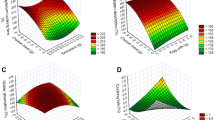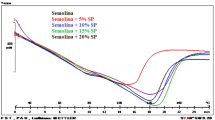Abstract
The addition of chicken meat, egg yolk and seaweed into instant noodles followed by drying using a continuous microwave oven instead of deep oil frying has been studied to increase the protein content of the protein-enriched, instant noodles (PEIN); however, the product has an inferior quality. This research aimed to improve the quality of the product by the addition of 3 hydrocolloids [guar gum (GG), xanthan gum (XG) and carboxymethyl cellulose (CMC)] alone or in combination at 3 levels (0, 1 and 2 g/100 g flour). The results showed that GG, XG and CMC significantly increased the viscosity of the starch mixture. They also improved the PEIN qualities by significantly decreasing the cooking loss to less than the control. The highest maximum tension force and maximum distance were found with XG addition. Moreover, all hydrocolloids also promoted microstructural improvement with a smooth surface and uniform pore structure. The optimum conditions were the addition per 100 g wheat flour of 1.6 g GG and 1.9 g CMC. Finally, the PEIN was moderately liked by 70 panelists at the moderately like. In conclusion, PEIN with hydrocolloid supplementation had a better quality than without, was convenient to serve, had an acceptable taste, with higher fiber and lower oil contents and higher protein (more than 25% protein) when compared to traditional instant noodle.




Similar content being viewed by others
References
AACC (2000) Approved methods of American Association of Cereal Chemists, 10th edn. American Association of Cereal Chemists, St. Paul Minnesota
AOAC (2012) Official methods of analysis, 16th edn. Association of Official Analytical Chemists, Washington
Bárcenas ME, O-Keller JD, Rosell CM (2009) Influence of different hydrocolloids on major wheat dough components (gluten and starch). J Food Eng 94:241–247
BeMiller JN (2011) Pasting, paste, and gel properties of starch-hydrocolloid combinations. Carbohyd Polym 86:386–423
Burešová I, Masaříková L, Hřivna L, Kulhanová S, Bureš D (2016) The comparison of the effect of sodium caseinate, calcium caseinate, carboxymethyl cellulose and xanthan gum on rice-buckwheat dough rheological characteristics and textural and sensory quality of bread. LWT Food Sci Technol 68:659–666
Bustos MC, Perez GT, Leon AE (2011) Effect of four types of dietary fiber on the technological quality of pasta. Food Sci Technol Int 17:213–221
Chaisawang M, Suphantharika M (2005) Effects of guar gum and xanthan gum additions on physical and rheological properties of cationic tapioca starch. Carbohyd Polym 61:288–295
Chaisawang M, Suphantharika M (2006) Pasting and rheological properties of native and anionic tapioca starches as modified by guar gum and xanthan gum. Food Hydrocoll 20:641–649
Chang HC, Wu LC (2008) Texture and quality properties of chinese fresh egg noodles formulated with green seaweed (monostroma nitidum) powder. J Food Sci 73:398–404
Choy A-L, May BK, Small DM (2012) The effects of acetylated potato starch and sodium carboxymethyl cellulose on the quality of instant fried noodles. Food Hydrocoll 26:2–8
De Pilli T, Giuliani R, Derossi A, Severini C (2008) Effects of microwave drying on lipid oxidation of stuffed pasta. J Am Oil Chem Soc 85:827–834
Guardeño LM, Catalá-Civera JM, Plaza-González P, Sanz T, Salvador A, Fiszman SM, Hernando I (2010) Dielectrical, microstructural and flow properties of sauce model systems based on starch, gums and salt. J Food Eng 98:34–43
Gull A, Prasad K, Kumar P (2016) Drying kinetics of millet, poamce and wheat based pasta and its effect on microstructure, color, water absorption and pasting properties. J Food Meas Charact 11:1–10
Huang CC (2009) Physicochemical, pasting and thermal properties of tuber starches as modified by guar gum and locust bean gum. Int J Food Sci Technol 44:50–57
Jayasena DD, Jung S, Bae YS, Park HB, Lee JH, Jo C (2015) Comparison of the amounts of endogenous bioactive compounds in raw and cooked meats from commercial broilers and indigenous chickens. J Food Compos Anal 37:20–24
Kaur A, Shevkani K, Singh N, Sharma P, Kaur S (2015) Effect of guar gum and xanthan gum on pasting and noodle-making properties of potato, corn and mung bean starches. J Food Sci Technol 52:8113–8121
Kishk YFM, Elsheshetawy HE, Mahmoud EAM (2011) Influence of isolated flaxseed mucilage as a non-starch polysaccharide on noodle quality. Int J Food Sci Technol 46:661–668
Lü Y-G, Chen J, Li X-Q, Ren L, He Y-Q, Qu L-B (2014) Study on processing and quality improvement of frozen noodles. LWT Food Sci Technol 59:403–410
Menon R, Padmaja G, Sajeev MS (2015) Ultrastructural and starch digestibility characteristics of sweet potato spaghetti: effects of edible gums and fibers. Int J Food Prop 18:1231–1247
Mirhosseini H, Abdul Rashid NF, Tabatabaee Amid B, Cheong KW, Kazemi M, Zulkurnain M (2015) Effect of partial replacement of corn flour with durian seed flour and pumpkin flour on cooking yield, texture properties, and sensory attributes of gluten free pasta. LWT Food Sci Technol 63:184–190
Mohamed S, Hashim SN, Rahman HA (2012) Seaweeds: A sustainable functional food for complementary and alternative therapy. Trends Food Sci Technol 23:83–96
Mohammadia M, Sadeghniaa N, Azizib MH, Neyestanic TR, Mortazavian AM (2014) Development of gluten-free flat bread using hydrocolloids: xanthan and CMC. J Ind Eng Chem 20:1812–1818
Padalino L, Mastromatteo M, De Vita P, Maria Ficco DB, Del Nobile MA (2013) Effects of hydrocolloids on chemical properties and cooking quality of gluten-free spaghetti. Int J Food Sci Technol 48:972–983
Pan Z-L, Ai Z-L, Wang T, Wang Y-h, Zhang X-l (2016) Effect of hydrocolloids on the energy consumption and quality of frozen noodles. J Food Sci Technol 53:2414–2421
Parvathy U, Bindu J, Joshy CG (2016) Development and optimization of fish-fortified instant noodles using response surface methodology. Int J Food Sci Technol 52:608–616
Pereira PM, Vicente AF (2013) Meat nutritional composition and nutritive role in the human diet. Meat Sci 93:586–592
Pongpichaiudom A, Songsermpong S (2018) Evaluation of microstructure and quality characteristics of microwave-dried instant noodles enriched with chicken meat, egg yolk, and seaweed. J Food Meas Charact 12:22–34
Prabhasankar P et al (2009) Edible Japanese seaweed, wakame (Undaria pinnatifida) as an ingredient in pasta: chemical, functional and structural evaluation. Food Chem 115:501–508
Ribotta PD, Ausar SF, Beltramo DM, León AE (2005) Interactions of hydrocolloids and sonicated-gluten proteins. Food Hydrocoll 19:93–99
Rojas JA, Rosell CM, Benedito de Barber C (1999) Pasting properties of different wheat flour-hydrocolloid systems. Food Hydrocoll 13:27–33
Shittu TA, Aminu RA, Abulude EO (2009) Functional effects of xanthan gum on composite cassava-wheat dough and bread. Food Hydrocoll 23:2254–2260
Silva E, Birkenhake M, Scholten E, Sagis LMC, van der Linden E (2013) Controlling rheology and structure of sweet potato starch noodles with high broccoli powder content by hydrocolloids. Food Hydrocoll 30:42–52
Škara N, Novotni D, Čukelj N, Smerdel B, Ćurić D (2013) Combined effects of inulin, pectin and guar gum on the quality and stability of partially baked frozen bread. Food Hydrocoll 30:428–436
Vijayakumar TP, Boopathy P (2014) Optimization of ingredients for noodle preparation using response surface methodology. J Food Sci Technol 51:1501–1508
Yalcin S, Basman A (2008) Effects of gelatinisation level, gum and transglutaminase on the quality characteristics of rice noodle. Int J Food Sci Technol 43:1637–1644
Zhou Y, Cao H, Hou M, Nirasawa S, Tatsumi E, Foster TJ, Cheng Y (2013) Effect of konjac glucomannan on physical and sensory properties of noodles made from low-protein wheat flour. Food Res Int 51:879–885
Acknowledgements
The authors are grateful to the Researcher for Industry (RRI) Program of the Thailand Research Fund and to Thai President Foods Public Company Limited for financial support.
Author information
Authors and Affiliations
Corresponding author
Rights and permissions
About this article
Cite this article
Pongpichaiudom, A., Songsermpong, S. Improvement of microwave-dried, protein-enriched, instant noodles by using hydrocolloids. J Food Sci Technol 55, 2610–2620 (2018). https://doi.org/10.1007/s13197-018-3182-2
Revised:
Accepted:
Published:
Issue Date:
DOI: https://doi.org/10.1007/s13197-018-3182-2




